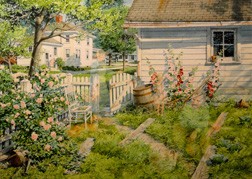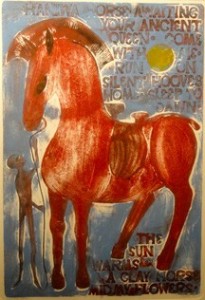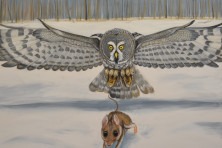Preserving & Collecting Wisconsin Art
- Share
- Tweet
- Pin
- Share

“The Nelson Place,” egg tempera, 1968, by Gerhard Miller
A statement from the President of the Art Institute of Chicago regarding its museum permanent collections is echoed by all who collect, conserve, and exhibit:
“An art museum has no greater responsibility than to choose from among the many art works offered, those precious few that should enter its permanent collection. This is a choice born of education, experience, and fine judgment and is always made with the public interest in mind. Indeed, art museums exist in order to build their collections and hold them in trust for the communities they serve. These objects are in every meaningful way the public’s collection, assembled over many years and preserved for all time.”
The permanent collection at the Miller Art Museum in Sturgeon Bay has the following mission and parameters: “to collect master works of Wisconsin Art from 1900 on – in painting, drawing, prints, and photography.” Documenting and caring for a collection, now over 700 pieces, is an ongoing responsibility for the Curator Deborah Rosenthal. Rarely a day goes by that she is not performing some task specific to collection needs, whether it is an offer from someone to donate or sell a piece to the museum, recording, numbering, documenting the provenance of a piece, checking the humidity and temperature in the storage areas, making condition reports to determine conservation needs, which leads to ongoing expenses upgrading to museum standards of framing, acid free matting and UV glass.

“Home Grown,” watercolor, by Charles L. Peterson
In the fall of 2011, the museum undertook an exciting project by going “green,” completely changing over to LED lighting on both levels in all gallery spaces. The heat index was virtually eliminated with 80 percent energy savings. The LED bulbs are 85 percent full spectrum bulbs. The artwork on exhibit looks crisper and brighter, with the entire range of warm and cool colors manifested beautifully. Rotated pieces from the permanent collection exhibited for longer periods of time on the mezzanine level benefit greatly from this reduction in heat and UV output. A generous gift from the Ray Cordon Estate helped to make this long awaited dream project possible. Both Sturgeon Bay Utilities and Focus on Energy provided consultation and rebates, working closely with us throughout the project. It was a special day the lights went on, knowing we are better protecting the art work and saving over $1,800 a year in energy costs.
The Curator is the Chairman of the Art Acquisitions Committee that meets two to three times per year to review, consider and vote on offers by the public to accept gifts or purchases, and occasionally to make purchases outright. The amazing fact is that the majority of pieces are donated by an artist, family, or estate. It is important to note the committee does not accept everything presented to them. The first responsibility of the committee is to maintain the highest standards of excellence for the collection, to develop and maintain a collection that will stand the test of time. Current members of the committee in addition to Chairwoman Deborah Rosenthal include Jack Anderson, Malin Ekman, Carol Hobson, Lorraine Mengert, Charles L. Peterson, and myself.

“Haniwa Horse,” collagraph 1/10, by Isabel Beaudoin
With a collection this large, it is estimated to take over 10 years to exhibit every piece on the mezzanine rotating two to three times a year. A permanent collection can also go on loan to another institution with proper lighting, humidity, and security. The museum has a long-range goal of placing all images from the permanent collection on its website allowing visitors to browse through the entire collection. Currently on the site is an alphabetical listing of included artists with several images available. The museum also maintains in hard copy a record of all artists’ biographies and images in the collection for visitors to peruse.
A collection is never really completed as museums continue to broaden the scope of work by any given artist or add new artists as they mature. The committee also has compiled an artists “wish list” that helps focus their collecting responsibilities. With a collection of over 700 works by over 200 artists, it has grown exponentially since 1975 when Gerhard CF Miller donated the first painting, award winning egg tempera, “Pioneer Farm,” to the newly built art center and library! It is not only a major part of the museum mission, but also very gratifying to be a part of preserving the best art Wisconsin artists have to offer with a special focus on honoring and collecting artists in the Door County community who have mastered their craft. Accompanying this essay are a few examples of the stunning work in the Miller Art Museum collection, created for all of us to enjoy and savor for a lifetime.
The Miller Art Museum, open Mondays from 10 am – 8 pm and Saturdays from 10 am – 5 pm, is located at 107 S 4th Avenue in Sturgeon Bay. On exhibit through July 17 is “Suzanne Rose • Sketches • Photographic Observations.”
The museum will be closed July 18 – 20 to install “Focus on Color: 20 Artists.” A wine reception will be held on July 21 from 5 – 6:30 pm.


